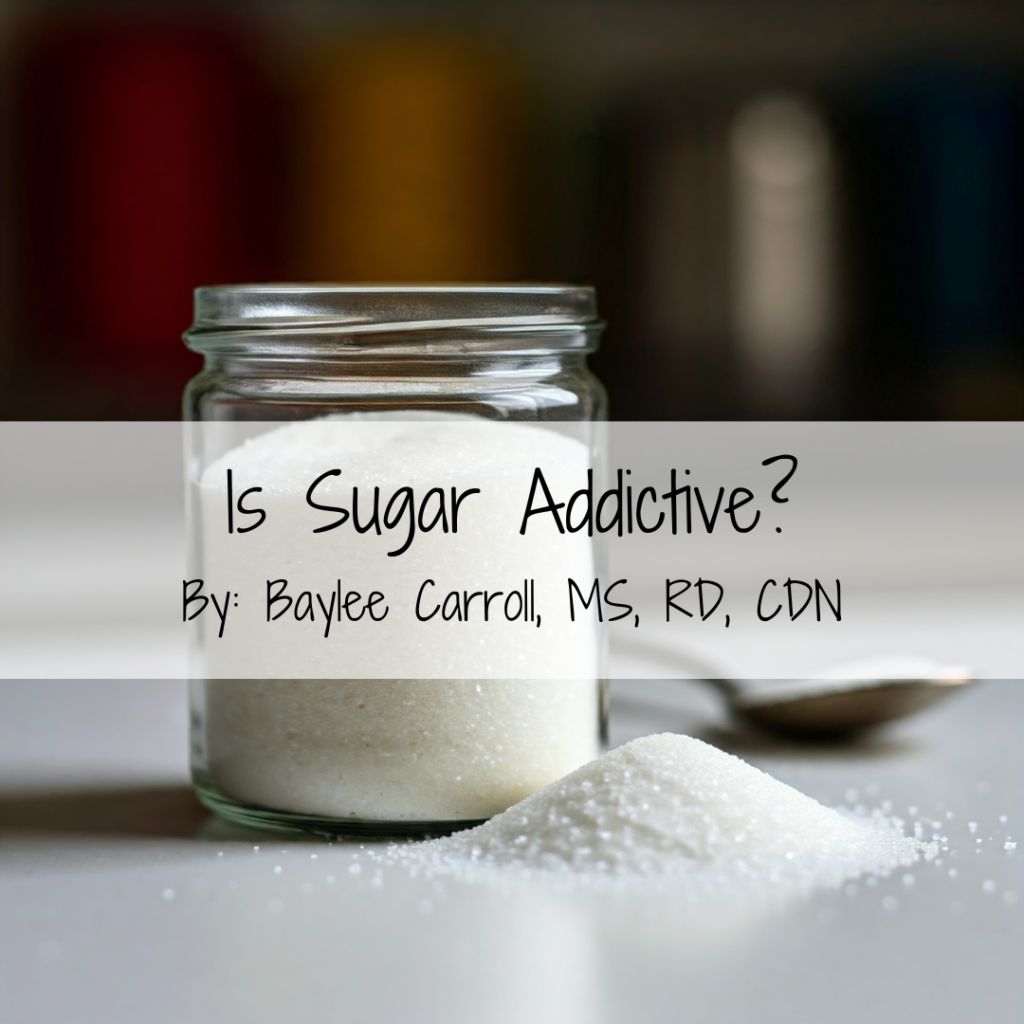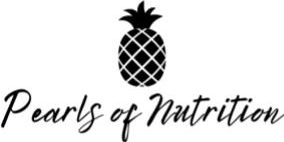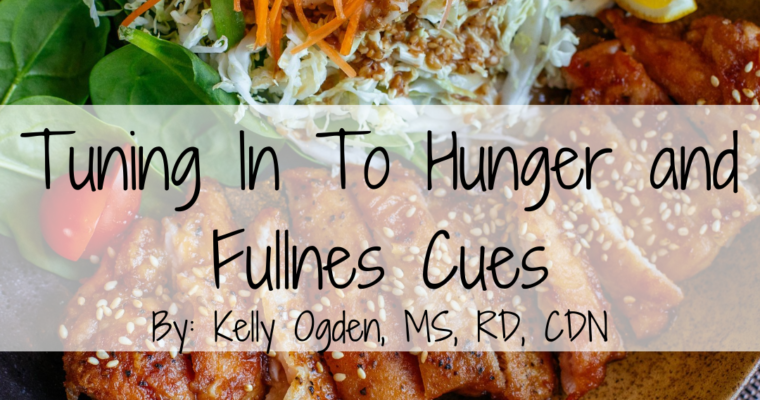
Feeling out of control around food can trigger a lot of emotions – it’s scary and often really triggering. It can be equally triggering to have constant thoughts about food. So it makes sense that people want to do what they can to maintain that control and have peace with food! Avoiding foods that seem to cause that experience, like sugar, makes sense on the surface. The question is though, does any one ingredient really cause these responses? Is sugar itself actually causing someone to lose control and obsess over it? Is sugar addictive?
What is sugar? And how does our body use it?
Before we talk about sugar, we have to talk about carbohydrates. Carbohydrates are our body’s primary source of energy. They can be broken down into simple carbohydrates or complex carbohydrates (see below). Simple carbohydrates are digested much quicker than complex carbohydrates and therefore provide energy to our bodies faster as a result. Sucrose, is the most commonly used sweetener, and is what we generally know as table sugar.
Simple carbohydrates, like sucrose, are more likely to cause a quick spike in blood sugars. However, how we consume these foods matters. The quantity of carbohydrates, speed at which we eat them, what we pair with them, and even the temperature of the food can all affect our blood sugars. The glycemic index was created as a way to measure the elevation in blood sugars, but generally does not take into consideration all of these additional factors.
After we eat carbohydrates, our body gets to work digesting them. The majority of the carbohydrates we consume (with the exception of some fructose and fiber, but that’s a conversation for another day!) are broken down into glucose. Glucose eventually makes its way to our blood supply where it is distributed to different tissues in our body, such as our muscle or other organs which need energy. The increase in blood glucose levels stimulates our pancreas to release the hormone insulin. Insulin stimulates the uptake of glucose by cells, which then use the glucose for energy. As a result, blood glucose levels fall and insulin secretion decreases.
Palatability
When a food is considered palatable, that means it is pleasant to taste. More literally, it means it is agreeable to the palate. Most would agree sugar tastes pretty darn good. We have taste receptors specific for sweet things, so again, we tend to enjoy foods that are sweet (whether they are from a nutritive or non-nutritive sweetener source). Sugars affect palatability in other ways too though! Yes sugar itself tastes pretty good, but it actually also interacts with other molecules to create new flavors and aromas when cooked. Additionally, sugar helps food retain water, making it more moist. Sugar also interacts with fat to create a leavening agent (helps the food rise). So it helps with taste and texture in numerous ways! This positive impact on palatability is why sugar so often shows up in different recipes and processed foods. There is a large amount of animal neuroscience literature that points to sweetness (taste) and palatability as the critical elements of addictive-like eating, not sugar itself.
What is the Evidence for Sugar Addiction?
First is it important to note that “Food Addiction” is not currently included as a recognized or provisional diagnostic category in the DSM 5, so neither is sugar addiction. Additionally, there is still a debate about how to define food addiction, so again, sugar addiction would be incredibly difficult to define as well. Lastly, a large portion of the research on this topic is limited to animal studies which have a narrow application in humans and are therefore best used as preliminary studies.
The thought that sugar may be addictive generally relates to how glucose levels change following consumption. As mentioned earlier, there is a postprandial (after eating) blood glucose spike and then eventually blood glucose levels drop. When blood glucose levels drop too low, it is considered hypoglycemia. A hypoglycemic state has been associated with increased cravings causing subsequent increased food intake. Additionally, insulin itself has been found to interact with dopamine in a way that heightens the reward response to foods and encourages consumption.
Although this mechanism would make sense, studies in humans have shown that a combination of sugar and fat is more commonly associated with addictive symptoms than sugar alone. This often leads researchers to believe that more processed and highly palatable foods are most addictive. However, there is evidence that even this may not be there. A study that looked at the addictive potential of certain foods found that nuts are more addictive on average than granola bars. This is an interesting outcome as a granola bar is a more processed food that generally contains added sugars… Now one study isn’t enough to create conclusive evidence, but it’s something to be considered!
The Role of Deprivation
There is some evidence that acute and prolonged caloric deprivation increases the reward value of food. This is true especially in energy dense and palatable foods. This may partially explain why diets characterized by caloric restriction for weight loss often ultimately lead to weight regain. Since the reward value of food is increased even during short periods of restriction, such as an intentional fast, there may be an increase in total food intake later and the foods chosen may be more calorically dense while simultaneously less nutritionally dense. Meaning, when you intentionally try to eat less, as a result you may be subconsciously seeking out and eating more highly palatable foods.
Relationship to eating disorders
As mentioned previously, neither food addiction nor sugar addiction are a recognized diagnosis at this time. One of the reasons it would be incredibly difficult to diagnose a person with either condition is due to the very significant overlap between food addiction and eating disorders. When using the Yale Food Addiction Scale (YFAS) as a standard, it was found that eating disorders were comorbid with food addiction 57.6% of the time in those with binge eating disorder and 86% of the time in those with bulimia, compared with 16.5% of the time in a population without an eating disorder diagnosis. In one study it was actually found that all women with active bulimia nervosa also met criteria for food addiction. That same study also found that 30% of people in remission met the criteria and none of the people in the control group (so no bulimia diagnosis) met the criteria for food addiction. The concern with this significant overlap is that it is possible that the YFAS may not be identifying a food addiction, but rather an eating disorder.
Takeaways
There is not enough evidence to definitively support the existence, and therefore a diagnosis, of a sugar addiction at this point. With that in mind, if you are feeling out of control around sugary foods, it may be beneficial to consider other contributing causes. Have you been dieting or restricting food intake? Are your meals generally well balanced with protein and fiber? Is there an emotional trigger that food is helping you cope with?
Working on your relationship with food is difficult, especially when there is a fear around a particular food or ingredient. If you are concerned you may have a sugar addiction, consider bringing this up with your Registered Dietitian. If you aren’t yet working with a Registered Dietitian, I would encourage you to consider connecting with one to help you better understand this topic.
References
Gearhardt, A. N., & Schulte, E. M. (2021, June 21). Is Food Addictive? A Review of the Science. Annual Review of Nutrition, 41(1), 387-410. https://www.annualreviews.org/content/journals/10.1146/annurev-nutr-110420-111710
Gordon, E. L., Ariel-Donges, A. H., & Merlo, L. J. (2018, April 12). What Is the Evidence for “Food Addiction?” A Systematic Review. Nutrients. https://www.ncbi.nlm.nih.gov/pmc/articles/PMC5946262/
Gropper, S. S., Smith, J. L., & Groff, J. L. (2009). Advanced Nutrition and Human Metabolism. Cengage Learning. https://repository.poltekkes-kaltim.ac.id/1170/1/9.%20Advanced%20Nutrition%20and%20Human%20Metabolism.pdf
Schulte, E. M., Avena, N. M., & Gearhardt, A. N. (2015, February 18). Which Foods May Be Addictive? The Roles of Processing, Fat Content, and Glycemic Load. PLOS ONE. https://journals.plos.org/plosone/article?id=10.1371/journal.pone.0117959
Stice, A., Burger, K., & Yokum, S. (2012, November 28). Caloric Deprivation Increases Responsivity of Attention and Reward Brain Regions to Intake, Anticipated Intake, and Images of Palatable Foods. Neuroimage, 67, 322-330. https://www.ncbi.nlm.nih.gov/pmc/articles/PMC3693571/
Westwater, M. L., Fletcher, P. C., & Ziauddeen, H. (2016, July 2). Sugar addiction: the state of the science. European Journal of Nutrition, 55(2), 55-69. https://www.ncbi.nlm.nih.gov/pmc/articles/PMC5174153/


